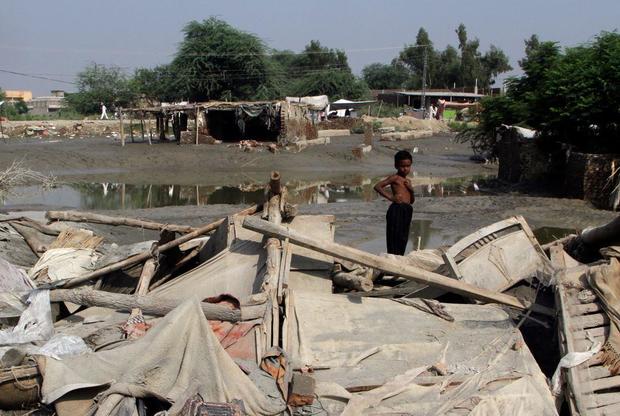[ad_1]
Islamabad — Just over a week after the world was alerted to the unfolding humanitarian catastrophe caused by devastating floods in Pakistan, foreign aid was staring to flow into the country of 220 million people to help those left stricken by the disaster. By Friday, planes carrying fresh supplies had formed an air bridge of relief as the death toll from the flooding surpassed 1,200.
Officials have said that at least 416 children are among the dead, and thousands of families are now among those increasingly at risk as waterborne diseases spread, and many Pakistanis remain homeless after the floodwaters and landslides destroyed their homes.
AP Photo/Mohammad Sajjad
A massive military-backed rescue operation was well underway to reach the 30 million people estimated to have been affected by the disaster. So far, Pakistan has received aid from China, Saudi Arabia, Qatar, Turkey, Uzbekistan and the UAE, among other countries.
The U.S. announced earlier this week that it would provide $30 million in aid for the flood victims, and on Friday, Colonel Joe Buccino, communications director for the U.S. military’s Central Command, said an assessment team would head to Islamabad “to determine what potential support DoD [Department of Defense] can provide to USAID as part of the United States’ assistance to the flooding crisis in Pakistan.”
The recent deluges are said to have submerged a third of the country, with climate change minister Sherry Rehman saying the “monster” monsoon floods had washed away 45% of the country’s crops, with the southeast province of Sindh hit particularly hard.
The overall damages from the flooding have been estimated at $10 billion.
As the aid has started to get to those who need it, the focus of relief efforts shifted largely to Sindh, where water levels in the river Indus were just starting to peak at the end of the week.
Local officials said around 1.2 million people had been left homeless in Sindh’s Dadu district alone, and they’ve warned people still in their homes to move to higher ground.
In May, residents in parts of Sindh saw the highest temperatures in the country, exceeding 122 degrees in some places. By Friday the floodwaters were receding across much of country, but some districts in Sindh remained underwater, and thing could still get worse.
“We’re on high alert as water arriving downstream from northern flooding is expected to enter the province over the next few days,” a Sindh government spokesperson said Thursday.
Fareed Khan/AP
Given that impending threat, hundreds of families in the province have taken refuge in makeshift camps along roads — the only dry ground in sight. But that creates its own risks: It emerged on Friday morning that three siblings, aged 18, 12 and 10, were killed when a speeding truck ran them over as they slept on the side of a main road.
The government and Pakistan’s army have established camps for flood evacuees in both the north and south of the country. As the situation in the north improves some residents have been allowed to leave the camps and return to their devastated homes. But the damage to roads and bridges remained an impediment to their safe passage.
In the 24 hours leading up to Friday afternoon, officials said at least 1,991 stranded individuals were rescued and 163 tons of relief materials delivered. More than 50,000 individuals have been moved to safer areas from disaster zones and 147 relief camps were up and running on Friday.
But despite the herculean efforts, many families were still out of reach, and some were complaining of a lack of direction on how to get help.
Shakeel Ahmad/Anadolu Agency/Getty
“We lost our house in the apocalyptic rain and floods, and no one has come to help us,” Naila Ali, who left Dadu with her six children and whatever belongings they could cram onto a donkey cart, told CBS News. “We will now go to my sister in Karachi and pray that the government will help us rebuild our lives.”
Pakistan’s largest civil society network, the Rural Support Programs (RSPN), was working across the flood zones, sending in aid and first responders. Shandana Khan, who heads the network, said its local organizations were working with the government and other charity groups to get relief to the people who need it.
“The relief goods and compensation are reaching some flood victims, but the task is mammoth,” she told CBS News. “This is the biggest calamity that we have had to deal with to date, in terms of number of people and area impacted.”
Climate impact “not a conspiracy, this is a reality”
Pakistan and the U.N. have blamed the global climate crisis — and the wealthy nations who’s carbon footprints have disproportionately fueled it — for the heavy monsoon rains that triggered the floods, and for speeding up the melting of Pakistan’s glaciers, which has exacerbated the crisis.
Asim Iftikhar, a spokesperson for Pakistan’s Foreign Ministry, said the disaster lent credibility to the warnings scientists have issued for years about climate change.
“This is not a conspiracy, this is a reality, and we need to be mindful,” he said.
Data published in 2019 showed that, since 1959, Pakistan had emitted about 0.4% of the heat-trapping carbon dioxide that poured into the environment, compared with 21.5% from the U.S. and 16.4% from China.
Pakistani officials say there has been a 400% increase in average rainfall this year in some regions, including Balochistan in the southwest and Sindh, which led to the extreme flooding.
Earlier this week, the United Nations and Pakistan issued a joint appeal for $160 million in emergency funding to help the estimated 33 million people affected by the floods. U.N. Secretary-General Antonio Guterres is scheduled to visit Pakistan on September 9 to discuss the ongoing relief effort with officials.
[ad_2]
Source link
(This article is generated through the syndicated feed sources, Financetin neither support nor own any part of this article)



